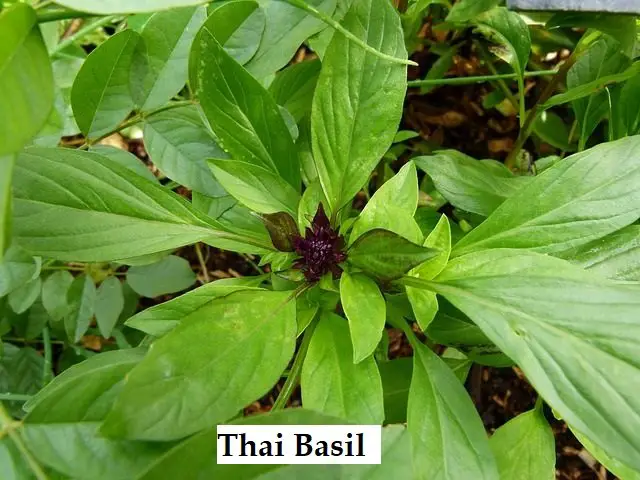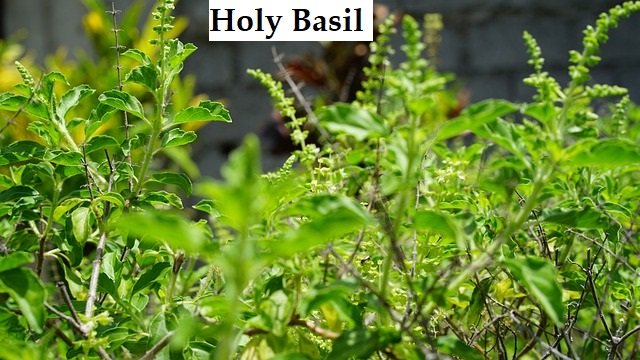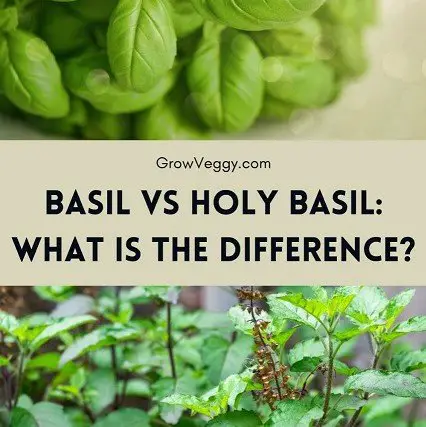Basil is an aromatic herb used in a lot of cuisines around the world. However, with over 60 varieties of basil, it can get confusing to differentiate between them.
The Thai basil and the Holy basil are both native to Asia, and therefore people often get confused between these two varieties. Let us find out how the Holy Basil and the Thai basil are similar and different.
Thai vs Holy Basil – Physical description
The Thai basil and Holy basil do not look very similar, so it is easy to differentiate between them with respect to looks.
Thai basil

Thai basil belongs to the Ocimum basilicum species.
It has smooth purple stems that just get more intense as they grow.
The leaves are shinier and greener than those of the Holy Basil as if they were made from a reflective material.
The Thai basil, along with green leaves, can also have purple leaves. The leaves are smooth at the edges.
Thai basil is a shrub that grows up to 12 inches tall.
It has lavender, pink or purple flowers.
Holy Basil

Holy basil belongs to the Ocimum tenuiflorum species. It is also popularly known as Tulsi.
Holy basil has green stems that are slightly hairy to touch.
Its leaves are oval and slightly larger in shape. The leaves are green in color and are sharp and jagged or toothed.
Some varieties, like the Krishna basil, do have purple leaves, but they are commonly grown in India and Nepal.
Holy basil is a shrub that can grow up to 12 to 20 inches tall.
It grows pretty purple flowers.
Thai basil Vs Holy basil – Taste
The tastes of Thai basil and Holy basil vastly differ and they have very different flavor profiles.
Thai Basil
Thai Basil is a highly aromatic herb. It has a strong flavor of licorice or anise, and a hint of cinnamon.
Thai Basil is mildly spicy but mostly sweet in taste. It belongs to the mint family, like all basils.
Holy Basil
The Holy basil is very flavorful, spicier in taste, with hints of sweetness and bitterness.
It has flavors similar to peppers and cloves, or even peppermints and lemons sometimes.
Growth Requirements of Thai Basil and Holy Basil
The Thai Basil is native to Southeast Asia, while the Holy Basil is especially native to India.
While these varieties are easily available in Asia, they are not as easy to find in the rest of the world, as the Genovese or sweet basil.
So it is a better option to buy seeds online and grow your own basil.
Thai Basil
As far as growth requirements go, Thai basil requires more attention than Holy basil. It has more demands with regard to the soil, water, and light conditions.
The soil should be fertile and constantly moist, but not soggy. The pH of the soil needs to be from 6.5 to 7.5, but preferably slightly low, meaning that the soil needs to be slightly acidic.
You can use coffee grounds to make the soil pH low. It should be well-aerated and rich in organic matter. For this reason, you will need to use fertilizer, either natural or store-bought, from time to time.
Thai basil is a tropical plant, so it needs a constant ambient temperature of 21 C and 6 to 8 hours of adequate sunlight every day.
If you do not prune the flowers regularly, the plant will waste no time in bolting.
If the climate is hot and dry, you can use mulch to retain the moisture.
Holy Basil
Holy basil is pretty simple to grow and does not require much effort. Grow it indoors preferably, in a small portable container.
Holy basil can grow even with just 5 hours of direct sunlight in a day, although its growth rate will be slow.
It grows well in neutral soil, which means that the pH should be 7. The soil is of utmost importance here, as this variety does not need a lot of organic matter as long as the soil is moist and well-drained. It can grow very well even with very less fertilizer.
If you are growing more than one plant, make sure to space them at least 2 feet apart so that the air can circulate freely.
Cooking
While Holy basil and Thai basil do have some similarities, they have quite different uses when it comes to cooking.
Thai Basil
Among the two, Thai basil is better as a cooking herb. The leaves of Thai basil are bigger and thicker. They retain their flavor and texture better after being cooked.
Thai, Vietnamese and Cambodian cuisines are great for involving Thai basil. Southeast Asian dishes such as Pho or Panang curry make use of Thai basil.
It can be used in drunken noodles, Thai basil chicken, curries, beef garnishes, etc.
As it tastes a bit like licorice, it is generally not used to make pesto, but if you do not mind the taste, then it can be used even for that purpose.
Holy Basil
Holy basil has smaller leaves. Unlike Thai basil, Holy basil is not very widely used in cooking except for Thai cuisine.
It is more used as a medicinal herb. In India, it is widely used in Ayurveda treatment since ancient times.
Holy basil has numerous health benefits. It is considered anti-oxidant, anti-viral, and anti-bacterial.
Dried leaves of holy basil are an excellent addition to tea, with their minty flavor and clove-like taste.
Fresh leaves of Holy basil can also be used in cooking recipes such as salads, stir-fries, soups, curries, or noodles. You can use Holy basil for an authentic version of drunken noodles. It is also used in red and green curries.
They are better added towards the end of the cook, as adding them earlier will devoid it of its flavor and texture.
The life span of Holy Basil and Thai Basil
When you use a plant like basil for its leaves, you look for a plentiful harvest. So it is important to know how long these plants will last.
Basil is an annual plant. However, both Thai basil and Holy basil are classified as “tender perennials”. This means that both plant varieties can last longer than a year.
Holy basil is a perennial plant and can live for up to 5 years if tended to properly.
Thai basil, on the other hand, is a tropical plant that is grown as an annual one.
This means that Thai basil is cultivated as an annual plant, although this plant can also live for 5 years.
However, if you do not live in a tropical climate, for them to grow big and last that long, the plant needs to be grown strictly indoors with a frost-free night temperature of more than 10 C.
They need to be pruned regularly as soon as they grow big enough.
Preservation
Both Thai basil and Holy basil are herbs that are best used fresh. Like all basil varieties, the best way to store them is to put them in a glass of water like cut flowers.
To preserve Holy basil leaves, dry them and store them in paper bags as you would do with tea leaves.
To preserve Thai basil, wash and dry the leaves with a paper towel and keep them in the freezer.
Both Thai basil and Holy basil do not stay well in the refrigerator, so try to avoid them as much as possible.
Medicine
Native to India, the Holy basil has a revered place in Ayurveda. You will find a Holy basil plant in almost all Indian homes. This plant is worshipped in India.
The Holy basil is well-known for the medicinal benefits that it provides. With multiple health and nutritional advantages, the Holy basil becomes a good herb to add to your diet.
Holy basil is also known to reduce stress and blood sugar. It helps fight bronchitis and stomach issues. It removes toxins from the body.
Substitute for each other
Thai basil and Holy basil have very different flavor profiles. Therefore it is not recommended that you swap them to be used as substitutes for each other.
Thai basil is used widely in Asian cuisines, especially in Thai dishes. Thai basil can withstand a higher temperature than Genovese basil.
This basil releases flavor better when it is cooked. It does not wilt very easily, making it ideal for garnishes in curries, salads, or soups, where it can release its flavor slowly.
Holy basil has a strong spicy flavor. As it tastes like peppers and cloves, it is mainly used as a spice herb.
The Holy basil, too, can withstand high temperatures and releases flavor as it heats up. It is used in a large variety of stir-fry dishes.
Thai basil adds a unique flavor to the dish with its licorice taste. Holy basil tastes good, but it does not have a unique taste as such and can be replaced very easily by some other spices or herbs.
However, Holy basil is not found very easily outside of Asia, so Thai basil is often used as a replacement. Thai basil is sweet, so although the dish will be aromatic, there will be no spiciness that comes from the Holy basil.
You need to be aware of the flavor profiles of both the basils in order to compensate one for the other.
You will also need to adjust the sweetness and spiciness by using substitutes according to the recipe.

